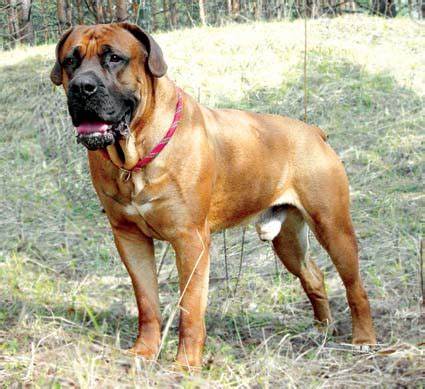
The Fila Brasileiro was developed in Brazil centuries ago as a large game hunting dog and working dog. These large dogs can be intimidating, but there is a reason why the saying, "faithful as a Fila" exists in Brazil.
This breed is also known as the Brazilian Mastiff, Brazilian Bloodhound, Cao de Brasil, Cao de Fila, and the Fila. Although these are purebred dogs, you may still find them in shelters and rescues. Remember to adopt! Don't shop if this is the breed for you.
More About This Breed
Highlights
Fila Brasileiros have high energy levels. Make sure your dog gets at least two to three good half-hour- to hour-long walks per day with a few good, active play sessions and shorter walks mixed in.
The Fila Brasileiro's coat can be brindle, fawn, or black. Sometimes, a Fila may have a black mask.
Their coats are smooth and short-haired, and they shed regularly. This means they don't make great choices for allergy sufferers.
Your Fila may not take well to other kids, like playmates, so it is important to set up boundaries for both the dog and kids. Teach your children how to properly interact with your Fila Brasileiro to prevent any unwanted injuries.
Filas can get along with other dogs their size but tend to view anything smaller as prey. Even with consistent training, Filas are hard-wired to chase down small animals like cats and smaller pups, and will likely be best suited as the only animal in the home.
The Brazilian Mastiff was bred to be loyal only to their owners, which means that consistent and early socialization is key to raising a Fila Brasileiro who won't become aggressive around visitors or strangers.
History
The exact origins of the Fila Brasileiro, including when the breed came into existence, aren't well-documented. Based on the Brazilian Mastiff's appearance, it's believed that the massive breed was created by crossbreeding English Mastiffs, Bulldogs, and Bloodhounds during the 1600s.
These large dogs were used by colonist plantation owners to fend off large predators like jaguars. They were also used to hunt and would track down livestock like cattle, sadly along with escaped enslaved people from the plantations, and grip them by the neck, holding them down until the dogs' humans arrived.
Despite their massive size, these guard dogs are agile. The Fila Brasileiro could chase at up to 35 MPH for their plantation owning humans, and then shift into a quiet, docile mode when relaxing with the family.
Centuries later, in 1946, the first breed standards for the Fila Brasileiro were published. The inhabitants of the city Sao Paulo were put in charge of keeping breeding records. In 1954, the Brasil Kennel Club (BKC) accepted the breed, and in 1960, so did the Fédération Cynologique Internationale (FCI).
The stranger-aggressive breed isn't recognized by show clubs like the American Kennel Club, as judges would not be able to inspect the watchful, powerful breed.
Size
Male Fila Brasileiro stand 25 to 30 inches from the shoulder and usually weigh in anywhere between 110 and 180 pounds Female Brazilian Mastiffs are slightly smaller, standing between 23 and 27 inches tall from the shoulder and weighing somewhere between 90 and 110 pounds. That said, many can be larger or smaller.
Health
Fila Brasileiro are generally healthy, but like all breeds, they can be subject to certain health conditions. Not all Filas will get any or all of these diseases, but it's important to be aware of them if you're considering this large breed.
Some of the more common health problems Fila Brasileiro suffer from include:
Hip and elbow dysplasia
Entropion
Bloat
Care
As with all dogs, you should keep up with your Fila Brasileiro's regular veterinary checkups to detect any health concerns early. Your vet can help you develop a care routine that will keep your dog healthy.
If not exercised properly, Filas are prone to weight gain, and they have high energy levels. Make sure your dog gets at least two to three good half-hour- to hour-long walks per day with a few good, active play sessions and shorter walks mixed in. This is a breed you simply cannot have without having a yard, and you should work in some active outdoor play sessions with your Fila as well, when weather permits.
Check their ears for debris and pests daily, and clean them as recommended by your vet. Trim your dog's nails before they get too long--usually once or twice per month. They should not be clicking against the floor. Your groomer can help with this.
You should brush their teeth daily, as many dogs are prone to dental issues. Your vet can instruct you on how to brush your dog's teeth properly.
:max_bytes(150000):strip_icc():format(webp)/what-horses-eat-that-keep-them-healthy-1886504-FINAL-5ba8dd3746e0fb0025eb2cb4.png)
:max_bytes(150000):strip_icc():format(webp)/horse-eye-resized-56a4dbf03df78cf77284fe95.jpg)
:max_bytes(150000):strip_icc():format(webp)/Horse-grooming-GettyImages-495726400-5876f27d5f9b584db351222e.jpg)
:max_bytes(150000):strip_icc():format(webp)/close-up-of-hand-holding-parrot-705172843-5b52bc4ec9e77c0037b6e5a4.jpg)
:max_bytes(150000):strip_icc():format(webp)/GettyImages-579524112-5c77331146e0fb000140a3a6.jpg)
:max_bytes(150000):strip_icc():format(webp)/budgerigarsonrope-331834_1920-5b628213c9e77c00255b32bc.jpg)
:max_bytes(150000):strip_icc():format(webp)/GettyImages-106887241-58325bc03df78c6f6a9a2ed2.jpg)
:max_bytes(150000):strip_icc():format(webp)/GettyImages-878015800-06106157c9d34a2081db4abcae8699b1.jpg)
:max_bytes(150000):strip_icc():format(webp)/hungry-cat-57b72fac5f9b58cdfda11a62.jpg)


:max_bytes(150000):strip_icc():format(webp)/4374985466_59c7f6545b_o-8b4f24f2f3e544349fe537fde58cfad0.jpg)
:max_bytes(150000):strip_icc():format(webp)/GettyImages-9298737261-500c5a2fba4248f89d1c17a33bf438f7.jpg)
:max_bytes(150000):strip_icc():format(webp)/veterinarian-and-owners-examining-dog-in-vet-s-surgery-164853745-dbecbdb691d549d79487d84356920cf4.jpg)